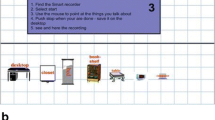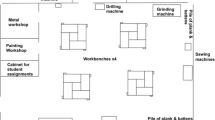Abstract
This paper begins with the view that the generation of meaning is a multimodal process. Props, drawings, graphs, gestures, as well as speech and written text are all mediators through which students construct new knowledge. Each semiotic context makes a unique contribution to the conceptualization of scientific entities. The human body, in particular, can function as a factor in both representation and explanation, serving as a link between verbal discourse and setting. Considering this perspective, a body-based activity was designed for kindergarten children, involving the concept of a shadow. The 3-D arrangement of the light from the light source, the human body (the obstacle), and the resulting shadow plays a central role. Using their own bodies as obstacles to the light, the children were able to explore the direction of the light and to change the relative positions of the light source and the obstacle. They formed hypotheses and were able to test them by moving on the stage. This body-centered activity explicitly incorporates the rectilinear movement of light into the process of shadow formation, while also providing learning through direct experience. Positive effects on learning were achieved for the group of children who participated in the activity, while the video analysis showed that many of the children were able to use their bodies to transfer to a different setting the embodied knowledge they acquired. This, according to researchers in the field of science education, is a powerful indication of conceptual change.











Similar content being viewed by others
Notes
Two-dimensional drawings conveying the idea of a third dimension (perspective).
References
Barab, S., & Dede, C. (2007). Games and immersive participatory simulations for science education: an emerging type of curricula. Journal of Science Education and Technology, 16(1), 1–3.
Barrow, L. (2007). Bringing light onto shadows. Science and Children, 44(9), 43–45.
Chang, N. (2005). Children’s drawings: science inquiry and beyond. Contemporary Issues in Early Childhood, 6(1), 1,104–106.
Chen, S.-M. (2009). Shadows: young Taiwanese children’s views and understanding. International Journal of Science Education, 31(1), 59–79.
Christidou, V., Kazela, K., Kakana, D., & Valakosta, M. (2009). Teaching magnetic attraction to preschool children: a comparison of different approaches. International Journal of Learning, 16(2), 115–128.
de Ruiter, J. P. (2007). Postcards from the mind: the relationship between speech, imagistic gesture, and thought. Gesture, 7(1), 21–38.
Eraut, M. (2009). Transfer of knowledge between education and workplace settings. Knowledge, Values and Educational Policy: A Critical Perspective, 65.
Fleer, M. (1996). Early learning about light: mapping preschool children’s thinking about light before, during and after involvement in a two week teaching program. International Journal of Science Education, 18(7), 819–836.
Georghiades, P. (2000). Beyond conceptual change learning in science education: focusing on transfer, durability and metacognition. Educational Research, 42(2), 119–139.
Georgoutsou, M., Panagiotaki, A., & Koliopoulos, D. (2010). Application of an educational programme on the concept of the shadow through the use of simulations on the website of the museum Cité des Sciences et de l’ Industrie. In A. Tzimogiannis (ed.), Proceedings of the 7th panhellenic conference on ICT in education], vol. ΙΙ (pp. 727–735). University of the Peloponnese, Corinth, 23–26 September 2010 (in Greek).
Givry, D., & Pantidos, P. (2012). Toward a multimodal approach of science teaching. Skhole, 17, 123–129.
Givry, D., & Roth, W.-M. (2006). Toward a new conception of conceptions: interplay of talk, gestures, and structures in the setting. Journal of Research in Science Teaching, 43, 1086–1109.
Grammatikopoulos, V., Gregoriadis, A., & Zachopoulou, E. (2012). Acknowledging the role of motor domain in creativity in early childhood education. Contemporary perspectives on research in creativity in early childhood education, 159–176.
Hadzigeorgiou, Y. (2003). Sound and light–water and air: a beginning in the natural sciences. Athens: Grigoris Press (in Greek).
Hadzigeorgiou, Y., Anastasiou, L., Konsolas, M., & Prevezanou, B. (2009). A study of the effect of preschool children’s participation in sensorimotor activities on their understanding of the mechanical equilibrium of a balance beam. Research in Science Education, 39(1), 39–55.
Huffaker, D. A., & Calvert, S. L. (2003). The new science of learning: active learning, metacognition, and transfer of knowledge in e-learning applications. Journal of Educational Computing Research, 29(3), 325–334.
Hwang, S., & Roth, W. M. (2011). The (embodied) performance of physics concepts in lectures. Research in Science Education, 41(4), 461–477.
Jaipal, K. (2010). Meaning making through multiple modalities in a biology classroom: a multimodal semiotics discourse analysis. Science Education, 94(1), 48–72.
Kamii, C., & Kato, Y. (Eds.). (2007). Piaget’s constructivism and early childhood education: I. physical knowledge activities. Okayama City: Daigaku Kyoiku.
Kress, G. (1997). Before writing: rethinking the paths to literacy. London and New York: Routledge.
Kress, G., Jewitt, C., Ogborn, J., & Tsatsarelis, C. (2001). Multimodal teaching and learning—the rhetorics of the science classroom. London and New York: Continuum.
Lemke, J. L. (2001). Articulating communities: sociocultural perspectives on science education. Journal of Research in Science Teaching, 38(3), 296–316.
Mathewson, J. H. (1999). Visual-spatial thinking: an aspect of science overlooked by educators. Science Education, 83(1), 33–54.
Murmann, L., & Schwedes, H. (1999). Learning processes concerning ‘light and shadow’ during science education in elementary school. Research in Science Education-Past, Present, and Future, 1, 110–112.
Ogborn, J., Kress, G., Martins, I., & McGillicuddy, K. (1996). Explaining science in the classroom. Buckingham/Philadelphia: Open University Press.
Osborne, J. F., Black, P., Meadows, J., & Smith, M. (1993). Young children’s (7–11) ideas about light and their development. International Journal of Science Education, 15(1), 83–93.
Pantidos, P. & Givry, D. (2014). Ambiguities in representing the concept of energy: a semiotic approach. Review of Science, Mathematics and ICT Education, 8.
Pantidos, P., Valakas, K., Ravanis, K., & Vitoratos, E. (2008). Towards applied semiotics: an analysis of iconic gestural signs regarding physics teaching in the light of theatre semiotics. Semiotica, 172(1/4), 201–231.
Pantidos, P., Valakas, K., Vitoratos, E., & Ravanis, K. (2010). The materiality of narrative spaces: a theatre semiotics perspective into the teaching of physics. Semiotica, 182(1/4), 305–325.
Papandreou, M. (2012). My shadow and me: children’s drawing in the context of teaching shadow formation in the kindergarten. In K. Plakitsi (Ed.), Sociocognitive and sociocultural approaches to science in early childhood (pp. 362–375). Athens: Patakis Press (in Greek).
Parker, J. (2006). Exploring the impact of varying degrees of cognitive conflict in the generation of both subject and pedagogical knowledge as primary trainee teachers learn about shadow formation. International Journal of Science Education, 28(13), 1545–1577.
Ping, R. M., & Goldin-Meadow, S. (2008). Hands in the air: using ungrounded iconic gestures to teach children conservation of quantity. Developmental Psychology, 44(5), 1277.
Pozzer-Ardenghi, L., & Roth, W. M. (2007). On performing concepts during science lectures. Science Education, 91(1), 96–114.
Pozzer-Ardenghi, L., & Roth, W.-M. (2010). Staging & performing scientific concepts: lecturing is thinking with hands, eyes, body, & signs. Rotterdam: Sense Publishers.
Rahm, J. (2004). Multiple modes of meaning‐making in a science center. Science Education, 88(2), 223–247.
Ravanis, K. (1994). The discovery of elementary magnetic properties in pre-school age. A qualitative and quantitative research within a Piagetian framework. European Early Childhood Education Research Journal, 2(2), 79–91.
Ravanis, K. (1996). Stratégies d’interventions didactiques pour l’initiation des enfants de l’école maternelle en sciences physiques. Spirale-Revue de Recherches en Éducation, 17, 161–176.
Ravanis, K., Zacharos, K., & Vellopoulou, A. (2010). The formation of shadows: the case of the position of a light source in relevance to the shadow. Acta Didactica Napocensia, 3(3), 1–6.
Ravanis, K., Christidou, V., & Hatzinikita, V. (2013). Enhancing conceptual change in preschool children’s representations of light: a sociocognitive approach. Research in Science Education, 43(6), 2257–2276.
Rennie, L. J., & Jarvis, T. (1995). Children’s choice of drawings to communicate their ideas about technology. Research in Science Education, 25(3), 239–252.
Rieber, L. P. (2005). Multimedia learning in games, simulations, and microworlds. The Cambridge handbook of multimedia learning, 549–567.
Roth, W.-M. (1998). Situated cognition and assessment of competence in science. Evaluation and Programming Planning, 21, 155–169.
Roth, W. M. (2001). Gestures: their role in teaching and learning. Review of Educational Research, 71(3), 365–392.
Roth, W. M. (2003). From epistemic (ergotic) actions to scientific discourse: the bridging function of gestures. Pragmatics and Cognition, 11(1), 141–170.
Roth, W.-M., & Lawless, D. (2002). Signs, deixis, and the emergence of scientific explanation. Semiotica, 138(1/4), 95–130.
Russell, T., Harlen, W., & Watt, D. (1989). Children’s ideas about evaporation. International Journal of Science Education, 11, 566–576.
Segal, G., & Cosgrove, M. (1993). The sun is sleeping now: early learning about light and shadows. Research in Science Education, 23, 276–285.
Sharp, J. (1995). Children’s astronomy: implications for curriculum developments at key stage 1 and the future of infant science in England and Wales. International Journal of Early Years Education, 3(3), 17–49.
Shepardson, D. P., Wee, B., Priddy, M., & Harbor, J. (2007). Students’ mental models of the environment. Journal of Research in Science Teaching, 44(2), 327–348.
Trend, R., Everett, L., & Dove, J. (2000). Interpreting primary children’s representations of mountains and mountainous landscapes and environments. Research in Science and Technological Education, 18(1), 85–112.
Trundle, K. & Hilson, M. (2012). Shadows play. Science and Children, 49(5).
Tsatsaroni, A., Ravanis, K., & Falaga, A. (2003). Studying the recontextualisation of science in preschool classrooms: drawing on Bernstein’s insights into teaching and learning practices. International Journal of Science and Mathematics Education, 1(4), 385–417.
Tytler, R., & Peterson, S. (2001). Deconstructing learning in science: young children’s responses to a classroom sequence on evaporation. Research in Science Education, 30(4), 339–355.
Tytler, R., Prain, V., & Peterson, S. (2007). Representational issues in students learning about evaporation. Research in Science Education, 37(3), 313–331.
Venville, G., Adey, P., Larkin, S., & Robertson, A. (2003). Fostering thinking through science in the early years of schooling. International Journal of Science Education, 25(11), 1313–1331.
Vincent, D., & Cassel, D. (2011). Shadows that enlighten. Science and Children, 48(5), 50–54.
Vosniadou, S., Skopeliti, I., & Ikospentaki, K. (2004). Modes of knowing and ways of reasoning in elementary astronomy. Cognitive Development, 19(2), 203–222.
Weil-Barais, A. (2001). Constructivist approaches and the teaching of science. Prospects, 31(2), 187–196.
Young, T., & Guy, M. (2008). Moon’s phases and the self shadow. Science and Children, 46(1), 30–35.
Acknowledgments
We would like to thank the artist Pantelis Constantinou for the drawings.
Author information
Authors and Affiliations
Corresponding author
Rights and permissions
About this article
Cite this article
Herakleioti, E., Pantidos, P. The Contribution of the Human Body in Young Children’s Explanations About Shadow Formation. Res Sci Educ 46, 21–42 (2016). https://doi.org/10.1007/s11165-014-9458-2
Published:
Issue Date:
DOI: https://doi.org/10.1007/s11165-014-9458-2




